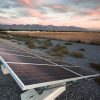Net metering lets customers tie small-scale renewable energy systems such as solar panels into the grid to offset their energy bills. With net metering, the electricity meter runs forward when the customer takes energy from the grid (such as at night when the solar panels aren’t generating) and it runs backwards when the home is feeding surplus energy into the grid (such as when the sun is shining and no one is home using appliances). At the end of the month, the utility charges the customer only for the net energy use. A customer who produces more energy than he uses earns kilowatt-hour credit that is applied to the next month’s electricity bill.
 Forty-four states have laws or rules governing net metering. States vary in the size of systems, number of meters on a property, and renewable energy technologies they allow; how customers are billed; how credits roll forward; and other parameters. In Wyoming, at the end of the calendar year, the utility pays the customer for any remaining energy credits at a wholesale rate. Wyoming’s law was created in 2001, and given that renewable energy systems have advanced over the last 15 years, is due for an update. For example, Wyoming only allows net-metered renewable energy systems up to 25 kilowatts. That’s more than enough for the average residential home, but too small to be worth the investment for larger buildings and facilities such as commercial businesses, government offices, and educational institutions.
Forty-four states have laws or rules governing net metering. States vary in the size of systems, number of meters on a property, and renewable energy technologies they allow; how customers are billed; how credits roll forward; and other parameters. In Wyoming, at the end of the calendar year, the utility pays the customer for any remaining energy credits at a wholesale rate. Wyoming’s law was created in 2001, and given that renewable energy systems have advanced over the last 15 years, is due for an update. For example, Wyoming only allows net-metered renewable energy systems up to 25 kilowatts. That’s more than enough for the average residential home, but too small to be worth the investment for larger buildings and facilities such as commercial businesses, government offices, and educational institutions.
Solar is booming across the country as customers clamor for low-carbon energy and cost savings. The solar energy sector now supports 218,000 jobs nationwide. Many states are inviting this economic surge by making their net metering laws more flexible to accommodate a wider range of renewable energy options such as wind and hydropower. A recent proposal to update Wyoming’s net metering law would have increased system size limit to 1 megawatt for non-residential facilities, allowed for multiple meters on a single utility bill, and adjusted the billing time period to April 1 to March 31 so that customers could use up credits they earn during the sunny summer over the darker winter months. Such changes could make new solar installations—and the jobs and energy savings that come with them—feasible in the state. However, utilities protested and the proposal failed in legislative committee.
By Stephanie Kessler
Stephanie Kessler is director of external relations for the Wyoming Outdoor Council.


